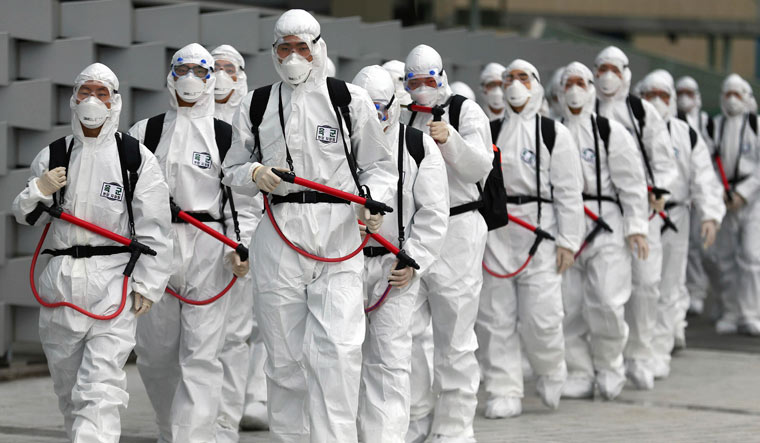The coronavirus outbreak, centred around China's Wuhan, has infected more than 85,000 people globally, with a reported 2,900 casualty count. The disease is on its way to becoming a global pandemic. On Saturday, the first death from the novel coronavirus was confirmed on US soil, in Washington state, after the first four cases of unknown origin were detected, indicating the disease was spreading in the country. The fatality occurred in King county, the most populous in the state and home to Seattle, a city of more than 700,000 people. The victim was not immediately identified. In Europe, the number of coronavirus cases from Italy has exceeded 1,000, with the death toll of 29. In Asia, South Korea—with the worst hit by the virus after China—confirmed a national total of 3,150 infections.
Additionally, a case of re-infection was confirmed in South Korea on Saturday—a 73-year-old woman tested positive for a second time after her recovery and release from hospital last week. At least 10 re-infection cases have already been reported in China.
What is the mortality rate of the virus?
It is an incredibly hard statistic to pinpoint, given the fluctuations in the severity of the disease across multiple variables. Scientists haven't yet zeroed in on how deadly the new virus really is. Deepening the mystery, the Case Fatality Rate (CFR) differs even within China. In the central China city of Wuhan, where the new coronavirus first exploded, 2 per cent to 4 per cent of patients have died, according to WHO. But in the rest of hard-hit China, the death rate was strikingly lower, 0.7 per cent.
A study by Zunyou Wu and Jennifer M. McGoogan in the Journal of American Medical Association (JAMA), analysing over 72,314 case records, has put the overall fatality rate at 2.3 per cent.
What explains the difference in infection and mortality rates between China (higher) and the rest of the world (lower)? The initial sluggish response of the Chinese government, and the fact that their healthcare system was completely swamped by the time the severity of the outbreak was recognised, can be considered one of the causes. In comparison, the rest of the world had a chance to screen patients at transit points, and quarantine those with a travel history and with symptoms (cough, fever).
How likely are you to survive a coronavirus infection?
It depends on numerous factors including, and not restricted to, age, gender and a history of pre-existing conditions.
By age:
A study by the Chinese Center for Disease Control and Prevention found that those above the age of 80 had the highest fatality rate among all age groups—the CFR stood at 14.8 per cent. No deaths occurred in the group aged 9 years and younger, but cases in those aged 70 to 79 years had an 8.0 per cent CFR.
Most infected patients were between 30 and 79 years of age (87 per cent), 1 per cent were aged 9 years or younger, 1 per cent were aged 10 to 19 years, and 3 per cent were aged 80 years or older.
By gender:
Put simply, the fatality rate for males is higher at 2.8 per cent when compared to females at 1.7 per cent. This disproportionality was also visible in the 2003 Severe Acute Respiratory Syndorme (SARS) outbreak in Hong Kong. A report in the Independent claimed that more women than men were infected by SARS, but the death rate among men was 50 per cent higher. The same for the Middle East Respiratory Syndrome (MERS) outbreak, where 32 per cent of infected men died, compared to 25.8 per cent of women. The report also goes on to state that, citing studies, women are, in general, far less suscpetible to viral infections—one possibility being that a strong immune system is necessary for childbirth, as offspring imbibe antibodies from mothers’ breast milk.
By occupation:
By occupation, patients who reported being retirees had the highest case fatality rate at 5.1 per cent.
By pre-existing conditions
Those with heart diseases, diabetes and other conditions run the risk of higher fatality rates. While patients who reported no pre-existing or co-morbid conditions had a case fatality rate of 0.9 per cent, patients with comorbid conditions had much higher rates—10.5 per cent for those with cardiovascular disease, 7.3 per cent for diabetes, 6.3 per cent for chronic respiratory disease, 6.0 per cent for hypertension, and 5.6 per cent for cancer, according to the JAMA report.
By severity of the disease
Many patients seek treatment at different stages of their infection. Unsurprisingly, those cases categorised as critical has the highest fatality rate—at 49.0 per cent. The fatality rates are extremely low for those with mild and even severe symptoms. According to the Chinese study: "In light of this rapid spread, it is fortunate that COVID-19 has been mild for 81 per cent of patients and has a very low overall case fatality rate of 2.3 per cent. Among the 1,023 deaths, a majority have been greater than 60 years of age and/or have had pre-existing, co-morbid conditions such as hypertension, cardiovascular disease, and diabetes. No deaths have occurred among those with mild or even severe symptoms."
According to available data, 81 per cent of coronavirus the infections were mild, 14 per cent were severe, and 5 per cent were deemed critical.
On average, however, WHO says people with mild cases recover in about two weeks, while those who are sicker can take anywhere from three to six weeks.


